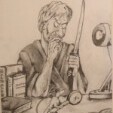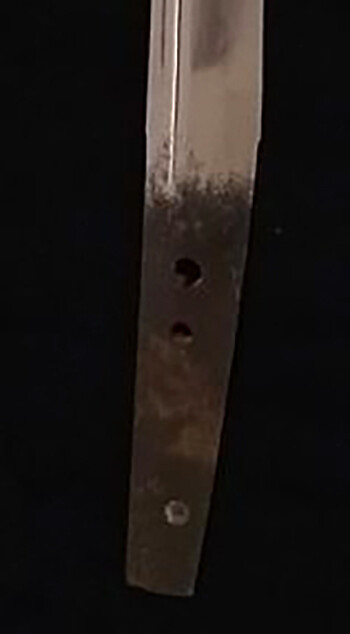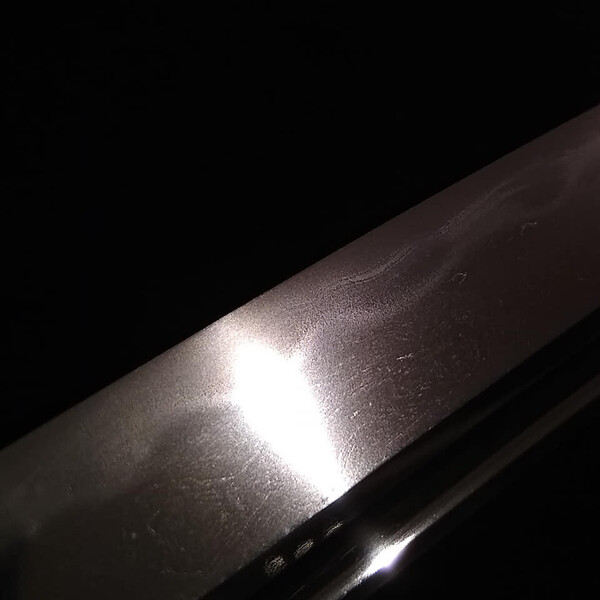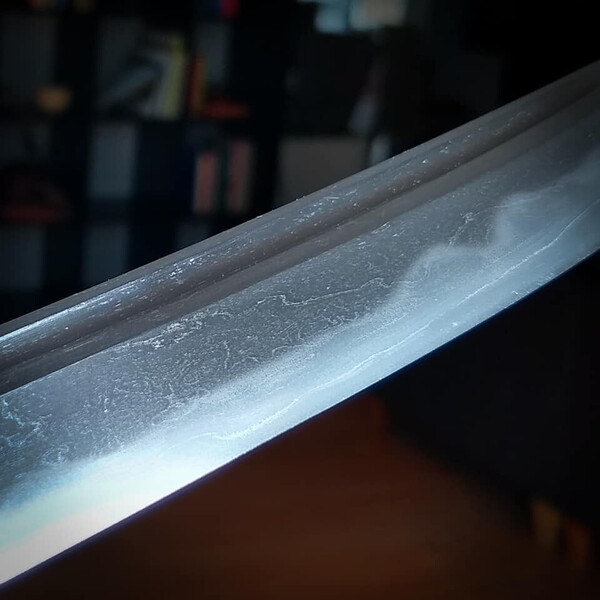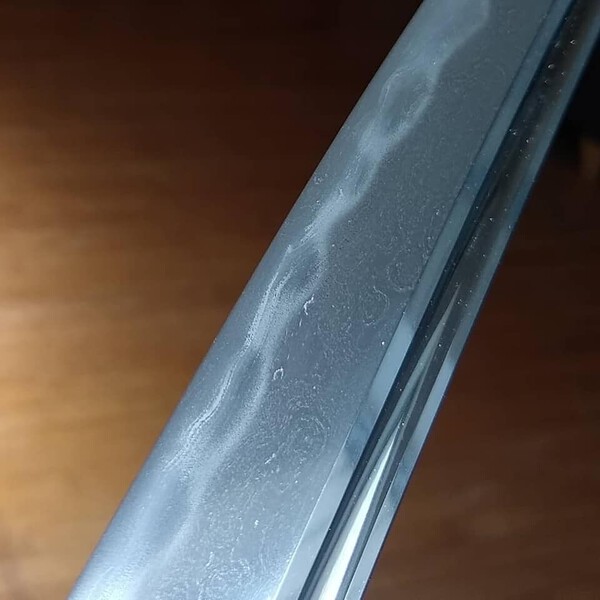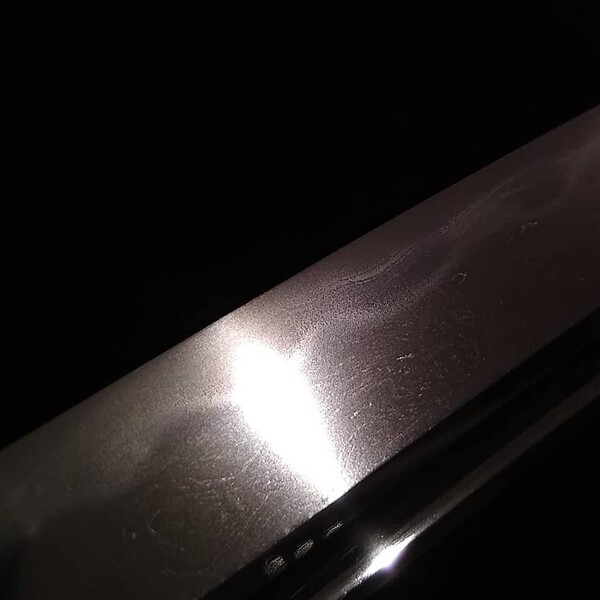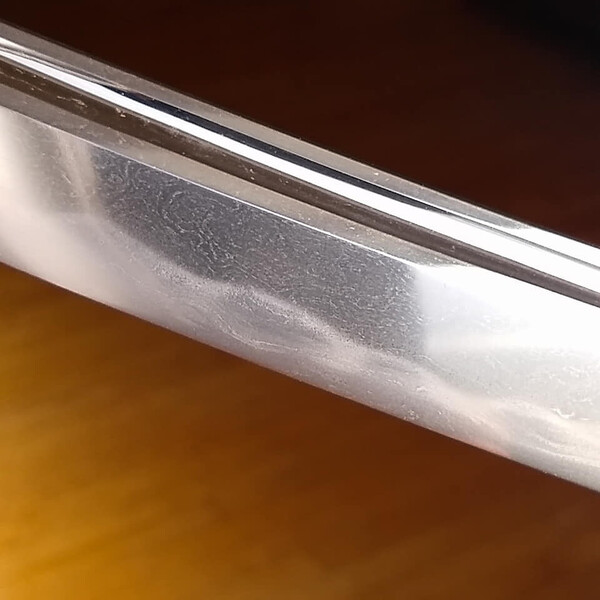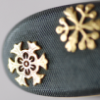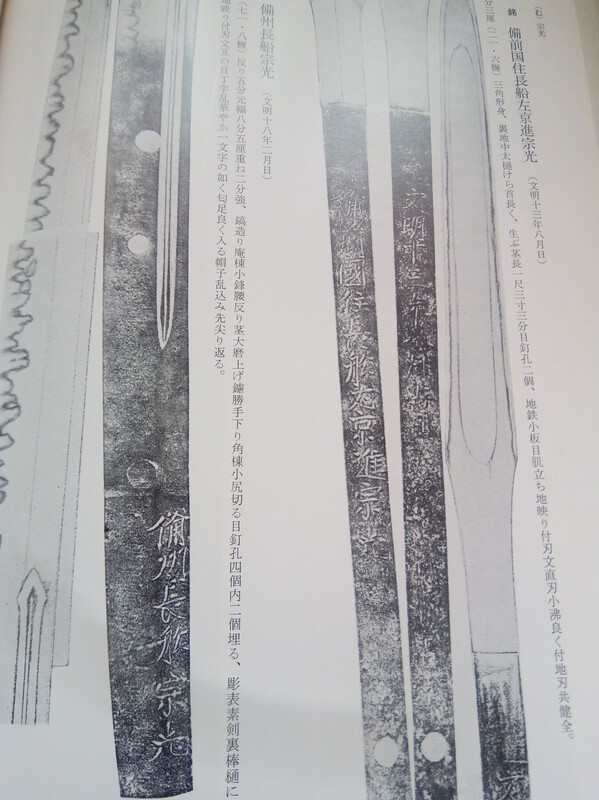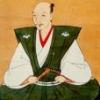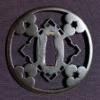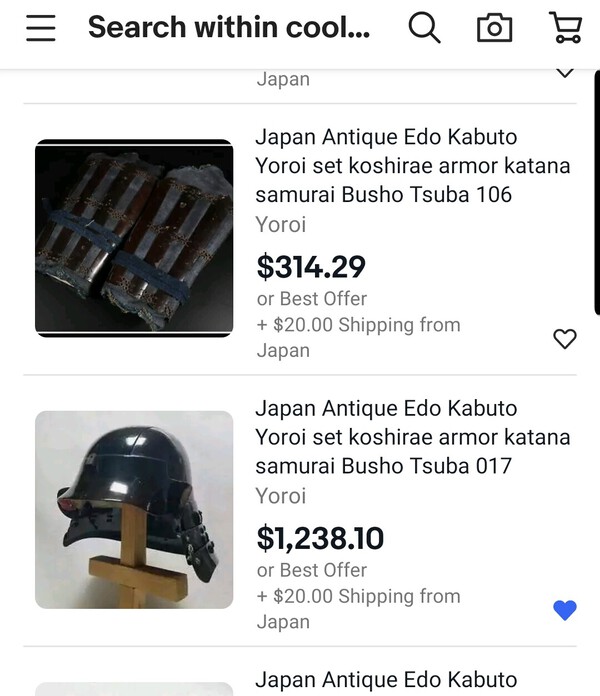Leaderboard
Popular Content
Showing content with the highest reputation on 09/01/2020 in all areas
-
For someone who has an interest in Soshu-den works, this is an extremely enjoyable sword to study. It is an o-suriage wakizashi which appears to be a Nanbokucho-period naginatanaoshi. The bo-hi appear to be ato-bori, and the upper portion of the blade is ubu (ie. the kaeri is intact). The jihada is an extremely beautiful, large pattern itame that is thickly covered in ji-nie and having areas which appear like yubashiri. Nie arcing out of the hamon becoming chikei in the ji. The hamon is generally midare, with areas of gonome-midare. There is deep nie-hataraki to the edge, including ashi, yo, kinsuji, sunagashi, etc. The hamon is brilliant. The nakago, as mentioned, is osuriage with 3 mekugi-ana (one plugged). The sword is very healthy and has a heavy feel in-hand. It is 7mm thick at the shinogi. The nagasa is 41.1cm and moto-haba is 31mm. The sword has two old attributions, which I will emphasize and make bold, are not to be considered guarantees of either attribution. One is an early Tokubetsu Kicho dated Showa 37 (1962) giving an attribution to Naoe Shizu. There is also an old sayagaki from Hon'ami Koson attributing the blade to Sa Kunihiro. Again in bold, the blade should be resubmitted to an NBTHK shinsa or discussed with Tanobe-sensei for a more current attribution. Regardless, this is an exceptional sword, and is whoever decides to purchase it is going to be very pleased. SOLD Kind regards, Ray10 points
-
From Markus Sesko's book Munemitsu (宗光), 1st gen., Shōwa (正和, 1312-1317), Bizen – „Bizen no Kuni Osafune-jū Munemitsu“ (備前国長船住宗光), first name „Genzō“ (源三), according to transmission a student of Nagamitsu (長光), other see him as younger brother of the latter, suguha mixed with ko-ashi, kataochi-gunome Munemitsu (宗光), 2nd gen., Jōji (貞治, 1362-1368), Bizen – „Bishū Osafune Munemitsu“ (備州長船宗光), hardly any blades are extant by the 2nd, 3rd and 4th gen. Osafune Munemitsu Munemitsu (宗光), 3rd gen., Ōei (応永, 1394-1428), Bizen – „Bishū Osafune Munemitsu“ (備州長船宗光) Munemitsu (宗光), 4th gen., Bun´an (文安, 1444-1449), Bizen – „Bishū Osafune Munemitsu“ (備州長船宗光) Munemitsu (宗光), 5th gen., Bunmei (文明, 1469-1487), Bizen – „Bizen no Kuni-jū Osafune Sakyō no Shin Munemitsu“ (備前国住長船 左京進宗光), „Bizen no Kuni Yukie-gun-jū Osafune Sakyō no Shin Munemitsu“ (備前国靭負郡住長船左京進宗光), „Bizen no Kuni Osafune Katsumitsu Munemitsu Bitchū Kusakabe ni oite saku“ (備前国長船勝光宗光備中於草壁作, „made by Bizen Osafune Katsumitsu and Munemitsu in Bitchū´s Kusakabe“), second son of Rokurōzaemon Sukemitsu (六郎左衛門祐光), „Sakyō no Shin“ (左京進), younger brother of Ukyō no Suke Katsumitsu (右京亮勝光), he was born in the ninth year of Eikyō (永享, 1437), there exist joint works with Katsumitsu and after the death of the latter also with his son Jirōzaemon Katsumitsu, we know date signature from the first year of Bunmei (1469) to the third year of Kyōroku (享禄, 1530) which shows us that he must had become more than 90 years, he supported the Sengokudaimyō Akamatsu Masanori (赤松政則, 1455-1496) – who gained temporarily control over the provinces Harima, Bizen and Mimasaka – in forging swords and accompanied him also to Harima province, there exist also works which were made in Kyōto and in a field camp in Ōmi province, mostly katateuchi with much niku, less tapering, and a short nakago are extant, tantō are also rather compact, have uchizori and a thick kasane, the jigane is a dense ko-mokume with ji-nie or a somewhat standing-out itame, the hamon is a gunome-chōji or suguha in nioideki mixed with ashi and yō and ko-nie, the jiba of the 5th gen. is more nie-loaden and does not show utsuri, he was also renowned as excellent horimono carver, ryō-wazamono, jōjō-saku Munemitsu (宗光), 6th gen., Tenbun (天文, 1532-1555), Bizen – „Bishū Osafune Munemitsu“ (備州長船宗光), „Bizen no Kuni-jū Osafune Sakyō no Shin Munemitsu tsukuru“ (備前国住長船左京進宗光造), blades with date signatures of the Tenbun era are attributed to a second generation Sakyō no Shin Munemitsus Munemitsu (宗光), 7th gen., Eiroku (永禄, 1558-1570), Bizen – „Bishū Osafune Sakon Munemitsu“ (備州長船左近宗光), „Bishū Osafune Tahei no Jō Munemitsu“ (備州長船太兵衛尉宗光), first name „Tahei“ (太兵衛), gunome-chōji, suguha, wazamono Munemitsu (宗光), 8th gen., Tenshō (天正, 1573-1592), Bizen – „Bishū no jū Osafune Saemonshichirō Fujiwara Munemitsu saku“ (備州之 住長船左衛門七郎藤原宗光作), first name „Saemonshichirō“ (左衛門七郎)3 points
-
Kirill, This may as you say be an interesting and worthwhile discussion to have. There is no doubt that any attribution of any artform made over 700 years ago is fraught with problems and that is no less true with Japanese swords. As has often been said here ultimately what any authenticating body does is offer opinion. The opinion of the NBTHK is worth a hell of a lot more than mine, and with respect yours, as it is based on a great deal more research than either of us could carry out in a single lifetime. What I fail to understand is why if you feel so strongly about this you don't start another thread rather than once again trying to hijack one with a tenuous link to the content and very little if anything to do with the OP. What is the possible advantage in doing that? If there is "Much to be said" why not say it in a dedicated post rather than adding here where it has little relevance to the original intention?3 points
-
3 points
-
3 points
-
I have never had the opportunity to handle blades of this level of attribution. However I do remember the absolute terror I felt when handed the first juyo papered blade I had ever seen and even greater fear when the owner handed it to my then 14 year old son to look at. I am glad to say neither of us caused it harm but I think I lost one or two years of life expectancy. However if I am honest I think I would be happy to have a high level sword (i.e. T.J). The reality is the way one would care for it would require the same regime as another sword. Also if brutally honest I think an experienced collector would be more likely to care for it properly than many museums who may not specialise in the subject and lack the resources to do it properly.2 points
-
Update to the above. Ushōshin is apparently Yanagawa Ushōshin 柳川右正心 (also listed on Rich Stein's and Jinsoo Kim's site). Thanks to George Trotter and Morita-san's posts from many years ago for resolving this for me.2 points
-
Just a side note the best packing that I have ever seen was shine by Ted Tenold who is also a wonderful guy and great to work with. He too is excellent at kantei.2 points
-
Just bought this at a estate auction of a guy who collected militaria. Took a chance and drove 12hrs/800 miles and paid off. Was hoping for NO competition and the locals thought it a common gunto. Anyway, as you can see the blade is dated May 1941 and has to be one of the earliest if not THE earliest sword known forged by Michimasa at the shrine forge. If anyone has seen or knows of a earlier dated blade let me know. Below is the or "my" translation but the family name (Kudo?) may be wrong as am not familiar with this name. Obviously this blade was made for this Haruhito and he probably was a Army Ofc as it comes in Army mounts w/matt rust colored lacquered saya. This is MASATADA's original name and has to be the first or one of the first blades made at the forge. I found a similar shrine sword by Michimasa that rec'd Hozon papers and it is dated July 1941. Neither that sword nor mine have the kikusui on the nakago but kikusui emblem is engraved on both sides of the habaki. Blade is in decent polish with no nicks no problems other than few minor scratches and blems which would easily polish out but I'm too f'n old and not sending this to Japan for polish - too easy to pass it on w/o a new polish. Let me know if a earlier dated blade is known - thanks. hamon is a kind of lazy gunome with profuse nie and short ashi. blade length is 26 1/4 " or 67.7cm tom w OMOTE; 昭和 十六年五月吉日 SHOWA 16 NEN 5 GATSU KICHIJITSU (MAY 1941 AUSPICIOUS DAY) 於 湊川 神社 村上道政作 OITE MINATOGAWA JINJA MURAKAMI MICHIMASA SAKU "MICHIMASA MURAKAMI MADE THIS AT THE MINATOGAWA SHRINE" URA; 謹呈 エ藤 治人博士 御左右 菊水 鍛刀會 KINTEI KUDO?,HARUHITO HAKASE GOSOU KIKUSUI TANTOKAI (PRESENTATION TO THE HONORABLE MR HARUHITO KUDO KIKUSUI ORDERED SWORD FORGING ASSOCIATION ) tsuba , all 6 seppa and fuchi marked; ー目1 point
-
1 point
-
Wow! That blade has a bit of everything, Ray. If I collected Soshu, I would jump on that - one heck of a study piece! For all newbies, this is exactly the kind of blade that you should be studying, not the ugly, cheap ones. This is a university course in Soshu.1 point
-
I felt terrible asking but the seller agreed to cancel my order. Had a good discussion on collections and armors with him. Seems a real great guy who is upgrading his collection with a registered complete armor set from the Minamoto clan coming his way hence wanting to make some room I consider this a reinforced lesson of what I already knew. Be patient, be wise and click with confidence only when the first two criteria have been duly met.1 point
-
Well, the thing is that these Origami follow a very standard, cookie-cutter approach and terminology. Once you see 3-5 translated a d know the main terms (kicho, Hozon, tokubetsu, mei, mumei, nagasa, bu, etc) you know what the origami is all about. The sayagaki are usuually more difficult, but they also follow a certain formula with the school/smith, length, date,1 point
-
Under STORE --> SUBSCRIPTIONS You already have one though. But it is what I am using for those who wish to upgrade membership....essentially the annual lump sum we all discussed that most chose to support the server move and upgrade. I did it as $30 for 6 months. There will also be a dealer subscription once I can approach some dealers, where they will have their own section that they can control, edit, delete, etc etc and advertise their goods without worrying about comments etc.1 point
-
1 point
-
Yanagawa Seishin (or Shōshin). Morita-san mentioned in his other post that this was the same person as Yanagawa Useishin (or Ushōshin), but he speculated that Seishin started adding the 右 to his name later in life to signify some life event (in this case, having returned from the war).1 point
-
Hi I have two very recent acquisitions and 'd like a bit of education which are in two separate posts Uwe has already given me some advice which I hope I've shown correctly I have contacted David Thatcher but his workload is massive! Kabuto Early/mid Edo kabuto. The urushi appears a bit too shiny considering it´s age. The base of the Eboshi, is an older six plate toppai-nari kabuto. Considering this, it is safe to assume, that superstructure is made of paper mâché (confirmed). Not an unusual way to create an eboshi kabuto. This will also explain the cracks and dents in the lacquer. I say lacquer instead of urushi, because I´m not sure if its urushi at all as the white edges on the cracks are making me suspicious. To sum it up, I think the whole helmet seems completely restored. Neck guard (shikoro) is newly lacquered and amateurishly laced. Also, its attachment to the helmet is incomplete, done only with the split shank rivets (hachi tsuke no byo). These ‘rivets’ are ‘posh’ paperclips My questions: Should it have the minimum restoration or left alone If restored what needs to be done Any other information will be of great help to me1 point
-
1 point
-
I kinda sorta get it. You are saying would someone owning the very top of the top really be able to enjoy it? I suspect in my case, probably not. It would likely be locked away most of the time, and just be a "I own one of those" thing. I wouldn't be able to take it out and really handle it much. Too much at stake. I would easily own a Juyo or higher. But something at that level...I guess would need to come with a mansion and armored glass display cases where I can view it in.1 point
-
If you own the item that they are advertising, you are in a good position to get this account shut down. Report it as fraud, note it is a unique one of a kind item and in your possession, and give them hell. Keep going until eBay closes that account. Won't stop them, but will be a great inconvenience.1 point
-
They are silvered, and the Saya is the usual colour that goes with them. It is an uncommon find, so please don't restore or paint.1 point
-
Oh yeah I would never get it replated. I will display it as it is now. I also have a Japanese family flag my grandfather brought back. From what some have told me the way its signed it seems to be a gift flag and not one a soldier carried. I have all the letters my grandfather sent home while in the war so I'm hoping I find somthing in there referencing both the sword and flag.1 point
-
This is the subject on which unfortunately much needs to be said, yet nothing is being said. Japanese nihonto experts are the sole exception in the whole world to claim the ability to suddenly reconstruct the detailed biographies of people who lived 700 years with no help of either contemporary documents or signatures. The defense is that "such biography makes sense" and "it explains the style". The drawbacks are however mostly three in nature: a. Destruction of later generation's signatures as the work is now being reattributed to the first generation. I just finished working with late Nambokucho Norishige school daito, and its amazing how many clearly Norishige inspired oshigata you find in old books, with dozens of names from Echigo, Etchu and Echizen. All signed. Yet today finding a single Echizen Chogi or shodai Momokawa is like a miracle. They exist only in old kantei tables as dozens for Etchu Tametsugu, while today essentially only three smiths in the whole school are papered to - Norishige, Etchu Tametsugu, Sanekage. Sometimes one sees Yasunobu. Kinju,Tomoshige are paperable because they are not strictly Norishige-like, same goes for some early Uda. In Shizu the problem is worse to the extent that a huge diversity of signatures just drops into the scene as one approaches Oei and the difference in style is such that the chances to paper as "genious Shizu" or even Sadamune becomes nil. Everything else is signatureless - yet Nanmbokucho Shizu and Yamato Shizu greatly exceed in number Naoe Shizu examples. One of the largest schools of the period, being attributed to a single person. Well, maybe now with the whole TWO generations. b. Japanese being Japanese, eventually the better works despite the late sugata will still get attributed to the "genius shodai". And then one wonders why Yukimitsu has 5-7cm long kissaki. This greatly confuses the learning, dating and eventually undermines the belief in papers, since a lot of such attributions do not hold when repapered. But in the mean time the experts collect a lot of fees from those seeking to find out if their blade can by any chance be the real genius and not some nidai shmuck. c. In the end the practice reinforces the belief in often artificially constructed lineages and relations. In no small part Norishige was traditionally sidelined since he has no clear lineage, and from a province filled at the time with heretics and semi-criminals. With Shizu the situation is even more bizarre - as despite the fact that Yamato is the only school which early Soshu can be mistaken with, only Awataguchi roots of Soshu are canonically accepted. Sure, someone from Yamato must have came to Kamakura - but I doubt it was to study as much as he was summoned to teach. Soshu hamon in nie, masame in ha, mokume sandwiched between masame in ha and at the mune - much of it bears witness of Yamato influence. It can be that not Kaneuji came to Kamakura, but Kanenaga, or Kaneyuki, or even Hosho Sadamune if he existed - and founded Soshu with the later generations of Awataguchi. Yet the possibility is destroyed by people claiming to be capable of nearly always (save some embarassments like ko uda) attributing a blade precisely to a person with absolutely no signatures, no clear contemporary records etc. etc. etc. to back it up. Kirill R.1 point
-
Hi Ozymay (if that isn't your name please let us know what is), Best guess is this was put together sometime no earlier than Meiji (late 19th century) and maybe as late as 1950, to sell to western tourist or the occupation force as a souvenir. The mounts are way too low end for a real samurai sword. If I'm correct, there won't be much to gain from removing the handle; what's underneath isn't very exciting. The blade is either glued in or a friction fit and attempts at removal risk damage. Where abouts in Minnesota? NMB is overrun with us lately. Cheers, Grey1 point
-
I'm sure all of you know and have interacted with Ray Singer and Swords of Japan before. He appears to be a respected voice on these boards and I am sure others as well. I became acquainted with Ray as of some direct information I picked up here with the suggestion to purchase an initial sword from someone on this site. Based on that information, I went to the Swords of Japan website and found a beautiful Takada Muneyuki Katana in a very reasonable range. After some initial discussions with Ray, including some wonderful background on the sword and the smith I decided to purchase the sword. That's where it all went downhill, for the sword. The transaction was professional and quick with the sword shipped to my house quickly thereafter. Sometime after it was dropped off at USPS, the sword fell out of the system. No scans were made, the delivery date came and went. This went on for a little over 5 weeks on a shipment that should have taken 4 days. During this whole time, Ray was working the system trying to find information for me to keep me up to date with the results. All told, he said he spent 50 hours on the phone with the USPS. Well, after 5 weeks, he finally decided all avenues had been exhausted and decided to make an insurance claim. Well as usually happens when that type of decision is made, USPS decides to walk up to my house and drop off the sword. The package was a little beat up but the sword inside was well packaged and unharmed. I really appreciate the efforts that Ray went through to make this happen. Most would have thrown up their hands after a week. With that, as long as I am in this hobby he has a customer. There is too much negative in this world and sometimes it's nice to focus on the positives. Jim Blubaugh1 point
-
Personal favorite: http://content.time.com/time/specials/packages/article/0,28804,1956922_1956921_1956924,00.html Elbow worth $50M1 point
-
Humbled by the kind words, thanks everyone. And to second Barry's comments above, Ted sets the absolute gold standard for packing Japanese swords. He's elevated the process to an art form, which anyone who has received a package from him will attest to.1 point
-
First, a thank you to Barry for all the assistance (and for the encouragement) in getting the article put together. Much appreciated, Barry! Happy to help anyone with an interest in this particular area of tsuba appreciation and scholarship, to the degree that I can. I just want to emphasize, too, that the theory I put forth in the article was (and remains) the best understanding I have of the Yamakichibei group, but that my views could change as new information comes to light. Cheers, Steve1 point
-
Yeah, I would NOT want to live with something like that, or anything of exceeding value, uniqueness etc. As Indiana Jones would say "That belongs in a museum!". The proper care, treatment, respect, etc would drive me insane. This also reminds me of a company that bought what was, at the time, the most expensive bottle of wine EVER sold at auction. They displayed it. Under hot lights. It became then the most expensive bottle of vinegar in the world.1 point
-
Mike, After getting home and looking at the "95" on my computer, I can see that the blade, and tsuba, are likely officer not NCO but stuck into an NCO saya. But pictures will tell us. Can't wait!1 point
-
1 point
-
Christian, Once COVID-19 is over, visit Japan. Go to DTI. Also, visit Sokendo and introduce yourself politely to Kurokawa-san. You will see what you are seeking, because they do exist.1 point
-
Ray is one of those dealers that gets consistent praise on the forum. Glad to see there was a good outcome.1 point
-
Hi Jim, thank you for sharing the story here and I am just relieved that the sword finally arrived. I will add to this that I needed to open investigations three times with USPS. The cases would be under investigation for a week at a time with no progress or call-backs, and then were simply closed. After this I opened investigations with Consumer Affairs first at the Florida side of the journey and then the California side. In retrospect, perhaps I should have initiated the claim at an earlier point but I continued to receive promises of a call-back "soon" with additional information, which were never fulfilled. As I told Jim in my last email, I am grateful and appreciative of his patience and understanding throughout this long process. Best regards, Ray1 point
-
Navy officer sword is 後藤廣正 Gotō Hiromasa Other sword is old. Looks to be centuries old (and possibly repurposed for the war). 備州長船囗囗 Bishū Osafune ?? Bishū is the name of a province in old Japan, corresponding roughly with present-day Okayama prefecture. Osafune is the name of a famous sword-producing region in Bishū province. The two names (Bishū Osafune) are often found together on swords. Many well-regarded smiths come from this region. Some more close-ups of that area of the tang might help us make out the actual name of the smith. Pictures of the whole sword would probably tell us more. Forgeries are common, so there is no guarantee the name on your sword is genuine, however it does look like an old tang and old signature.1 point
-
Dear Tony I am not aware of the exact chemical reactions behind it. But let me give it a try (everyone feel free to correct any mistakes made): shakudo is basically made from copper and copper produces a protective surface over the lapse of time or due to patination (which we call patina and which is no longer pure metallic). This patina (and not the metal itself) can be damaged by touching the surface with bare hands (due to the sweat which contains salts and water). You can easily see the results of such chemical reactions between human hands and copper when looking at modern copper coins. The shiny patina gets lost and the copper turns greenish/brownish. Enjoy this piece and I am very glad that there are still collectors willing to pay high-prices for high-quality tsuba! Best, Chris1 point
-
So being the ebay conossuier that I am (worlds largest flea market and I do love it for that knowing the risks) I discovered a scam seller thats popped up a lot recently in Japanese antiques. Basically what this seller does is take previously sold listings in Japanese antiques and copies/relists them at a higher price than they even originally sold for (bold bastards). Not only that they brazenly copy currently active listings for items such as a Jingasa I had asked about here. So be careful if you find an item you want and its from this seller, stop right there. They do not have the item, you will not receive it and its just a giant dummy operation. Im posting pics of the sellers profile. An image used by that seller of a Zunari Kabuto they have "for sale" that I had already purchased and received from another seller along with proof of that purchase. So beware......0 points




